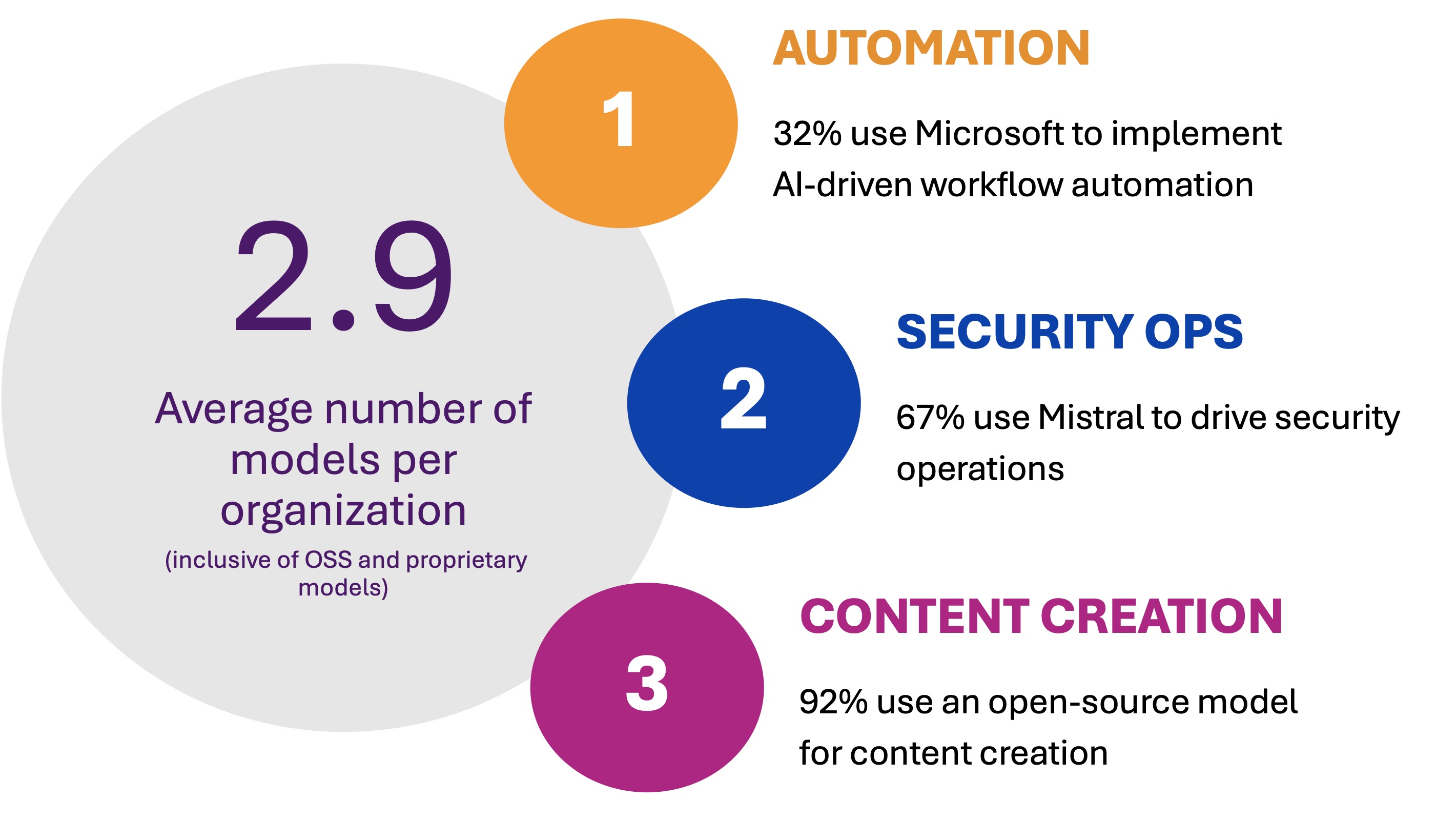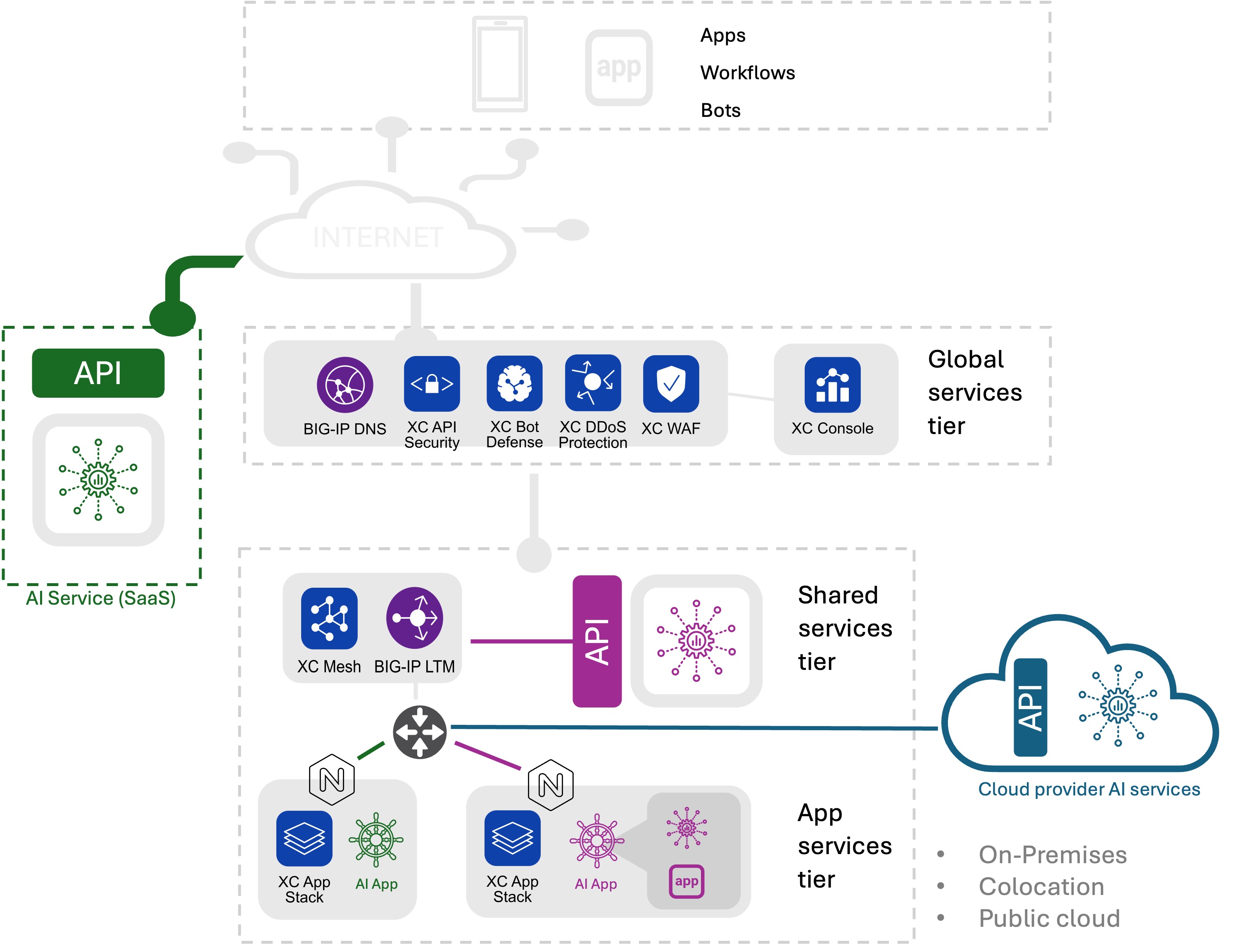Pas de « modèle unique pour tous les gouverner » avec l’IA générative
D'après les gros titres, OpenAI est le seul jeu d'IA générative en ville. On en parle dans toutes les conversations sur l’IA, même celle-ci. Mais ce n’est pas le seul service disponible, ni le seul modèle disponible.
En fait, l’adoption de l’IA générative dans les entreprises n’est pas aussi homogène que les gros titres pourraient nous le faire croire.
Nos recherches les plus récentes ont révélé que les organisations fonctionnent, en moyenne, avec près de trois modèles différents. La raison derrière ce choix semble être motivée par des cas d’utilisation.

Par exemple, il n’est pas étonnant que les opérations de sécurité s’orientent vers des modèles open source, que vous pouvez former en privé sans risquer de révéler vos processus ou vos données sensibles. Il en va de même pour la création de contenu, qui implique souvent de partager des données sensibles avec un modèle. Il n’est pas surprenant non plus que l’automatisation des flux de travail s’appuie sur les services hébergés de Microsoft, puisque de nombreuses organisations utilisent étroitement les solutions Microsoft, tant sur site que dans Azure.
Aucun modèle unique ne peut répondre à toutes les exigences techniques et commerciales de la liste croissante des cas d’utilisation de l’IA générative pour les entreprises.
Cela entraîne certains défis en matière de livraison, de sécurité et d'opérations générales des applications, car différents choix de modèles impliquent des modèles de déploiement différents.
Modèles de déploiement de l'IA émergents
Trois modèles de déploiement de base émergent. La principale différence réside dans la responsabilité opérationnelle de la mise à l’échelle des services d’inférence. Dans tous les modèles, l'organisation est responsable de la livraison et de la sécurité des applications.

- SaaS géré . Dans un modèle de déploiement géré SaaS, les applications d'IA utilisent des API pour accéder à un service géré par l'IA, à la manière d'OpenAI ChatGPT. La responsabilité opérationnelle de l’échelle incombe au fournisseur.
- Géré par le Cloud . Les modèles déployés gérés dans le cloud exploitent les services d'IA hébergés par les fournisseurs de cloud. Ces services sont toujours accessibles via une API mais peuvent être soit privés pour l’entreprise, soit partagés. Les applications d’IA elles-mêmes peuvent également se trouver dans le cloud public ou sur site. Lorsque le service est privé, l’entreprise assume la responsabilité de la mise à l’échelle des services d’inférence, ce qui peut constituer un défi car la plupart des organisations ont peu d’expérience dans la mise à l’échelle de grands modèles linguistiques. Lorsque le service est partagé, les organisations délèguent la responsabilité au fournisseur de cloud, mais doivent prendre en compte des facteurs tels que les quotas et les coûts basés sur les jetons dans le cadre de leurs opérations.
- Autogéré. Les modèles open source se déploient souvent en mode autogéré, que ce soit dans le cloud public ou sur site. Vous pouvez accéder aux modèles via une API ou directement par une application. Avec ce mode, vous assumez pleinement la responsabilité de l’évolutivité, de la sécurité et de la surveillance des services d’inférence.
(Pour une analyse plus approfondie de ces modèles, vous pouvez consulter ce blog de Chris Hain)
De nombreux fournisseurs hébergent des modèles open source pour soutenir un modèle SaaS géré, et beaucoup de fournisseurs de cloud proposent aussi l'open source comme service.
Les modèles OpenAI ne sont pas seulement accessibles en SaaS géré par OpenAI, mais également via un cloud géré par Microsoft. Mistral, un modèle open source reconnu, fonctionne avec les trois modèles de déploiement. C’est pourquoi le cas d’usage reste le moteur principal du choix du modèle, puisque les entreprises peuvent librement mixer modèles et modèles de déploiement.
Les organisations subissent déjà une forte pression, car elles doivent non seulement former les modèles, mais aussi les exploiter et les sécuriser. C’est pourquoi il est plus pertinent de choisir les modèles selon les cas d’usage, surtout quand l’expertise opérationnelle se fait rare. En concentrant vos ressources sur les cas d’usage qui, pour des raisons de sécurité ou de confidentialité, ne peuvent pas être déployés sur des modèles partagés, vous obtiendrez les meilleurs résultats.
Attention à la myopie opérationnelle
Mais méfiez-vous de la myopie opérationnelle, qui peut créer des silos au sein de votre organisation. Nous l'avons déjà observé avec le cloud computing, et cela va probablement se reproduire avec l’IA générative en entreprise. En sachant que l’isolation des opérations et de la sécurité selon le modèle présente un risque, vous pouvez éviter la complexité et les dangers associés en choisissant stratégiquement des modèles et des modes de déploiement qui tirent pleinement parti de vos ressources, capacités et budgets opérationnels.
Nous n’en sommes qu’aux premiers jours et au moment où vous lirez ces lignes, il y aura sans doute de nouveaux fournisseurs et de nouveaux modèles dotés de nouvelles capacités. Mais les modèles de déploiement resteront en grande partie les mêmes, ce qui permettra une planification plus stratégique des opérations, des budgets au personnel en passant par les services d'application dont vous aurez besoin pour sécuriser et faire évoluer les modèles que vous choisirez.
